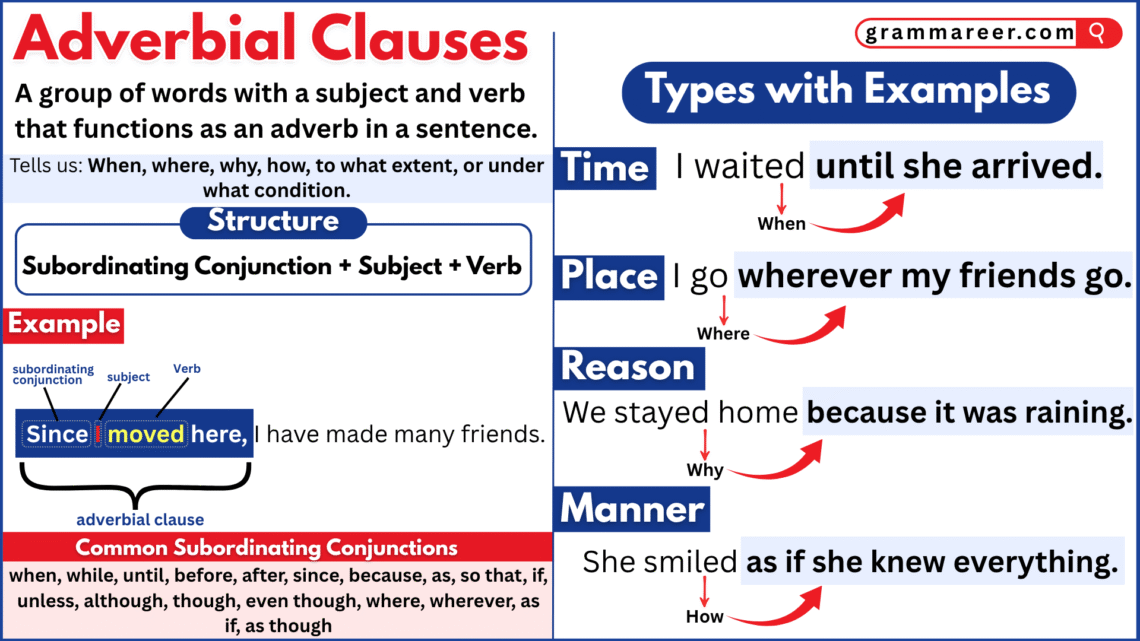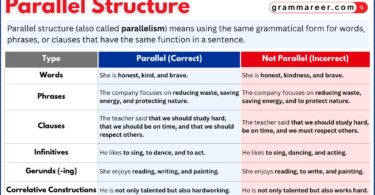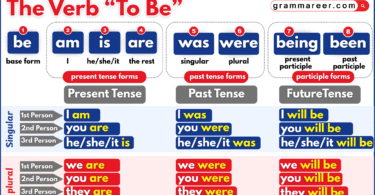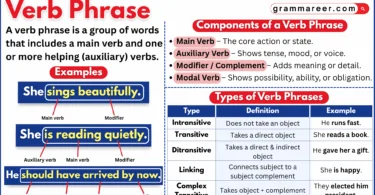When we speak or write, we often want to give more details about an action—like when it happened, why it happened, or how it happened. Sometimes a single word (an adverb) is enough, but other times we need a little more explanation. That’s where adverbial clauses come in, adding clarity and detail to our sentences.
In this article, we’ll explore what adverbial clauses are, the different types, and how to use them effectively with examples.
Table of Contents
What is an Adverbial Clause?
An adverbial clause is a group of words with a subject and a verb that works just like an adverb in a sentence. In other words, it gives us extra details about the action, telling us when, where, why, how, or under what condition something happens.
Unlike a full sentence, an adverbial clause cannot stand on its own; it always depends on the main clause to complete the meaning. That’s why it’s called a dependent clause.
Examples:
- I stayed inside because it was raining.
- (The clause because it was raining explains why I stayed inside.)
- She smiled when she saw her friend.
- (The clause when she saw her friend tells us when she smiled.)
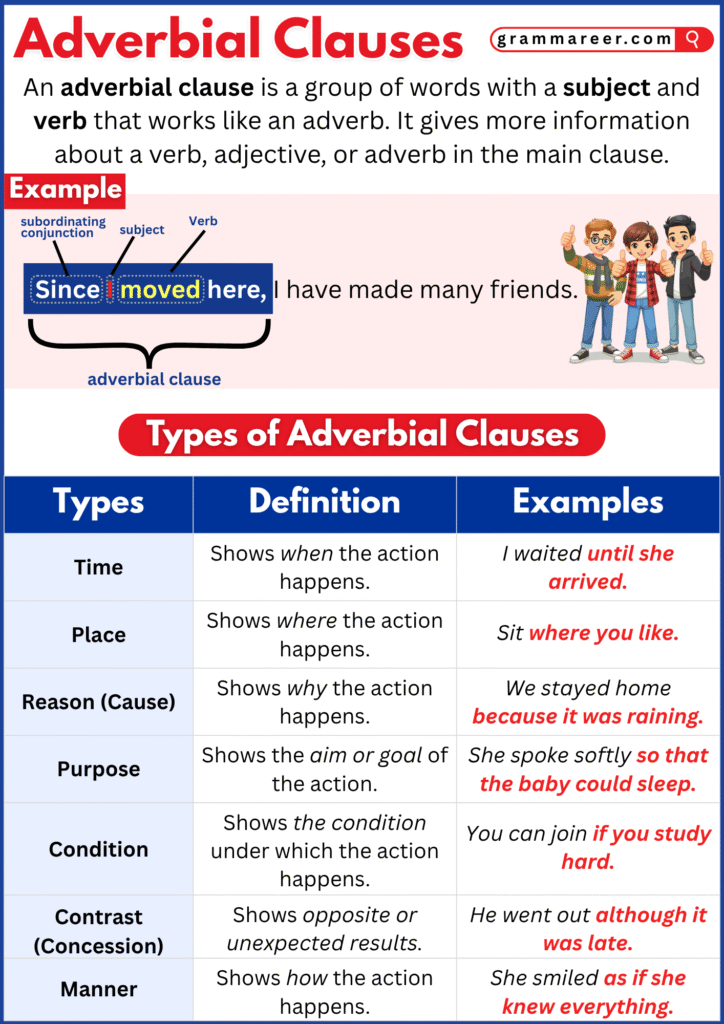
How to Use Adverbial Clauses?
Adverbial clauses are used to give extra details about the action in a sentence. They can explain when something happens, where it takes place, why it happens, how it happens, or under what condition it happens. This makes your sentences richer and easier to understand.
An adverbial clause always begins with a subordinating conjunction such as because, if, although, when, after, before, since, or while. These words act like a signal that an adverbial clause is coming.
Adverbial placement rules
You can place them at the beginning, middle, or end of a sentence, depending on what you want to highlight. Let’s look at how they work in each position.
Adverbial Clauses at the Beginning
When an adverbial clause comes at the start of a sentence, it is usually followed by a comma. This helps separate the dependent clause from the main clause.
Examples:
- If you study well, you will pass the test.
- Although it was raining, they went for a walk.
- Before you leave, check the door is locked.
Adverbial Clauses in the Middle
If the adverbial clause appears in the middle, it is usually set off with commas on both sides. Even if you remove it, the main sentence still makes sense.
Examples:
- My brother, because he was tired, went straight to bed.
- The teacher, although she was strict, cared for her students.
- This phone, since it is brand new, comes with a warranty.
Adverbial Clauses at the End
When an adverbial clause is placed at the end of a sentence, a comma is not usually needed unless it adds emphasis or clarity.
Examples:
- She stayed home because she was sick.
- I will call you when I reach the station.
- The children kept quiet until the teacher entered.
Adverbial Clause vs. Adverbial Phrase
Adverbial clauses and adverbial phrases might look similar because both give extra information about a verb, adjective, or another adverb. But there’s one key difference: an adverbial clause has a subject and a verb, while an adverbial phrase does not.
- An adverbial phrase is just a group of words acting like an adverb.
- An adverbial clause is a whole mini-sentence (with a subject and verb) that also acts like an adverb.
Examples of adverbial phrases:
- She ran with great speed.
- We’ll meet in the morning.
Examples of adverbial clauses:
- She ran because she was late.
- We’ll meet when the sun rises.
So, the phrase gives you detail in a shorter way, while the clause gives more complete information with its own subject and verb.
Types of adverbial clauses
Adverbial clauses can do different jobs in a sentence depending on the kind of information they give us. Some tell us when something happens, others explain why, how, where, or under what condition it happens. Let’s break them down into simple categories with examples.
| Type of Adverbial Clause | Function (What it shows) | Example |
| Time | Tells when something happens | I’ll call you when I get home. |
| Place | Tells where something happens | You can sit wherever you like. |
| Manner | Shows how something happens | She danced as if nobody was watching. |
| Reason | Explains why something happens | He stayed home because he was sick. |
| Condition | Explains what happens if/unless something else happens | We’ll go out if the weather improves. |
| Purpose | Explains the goal or aim of an action | She spoke slowly so that everyone could understand. |
| Comparison | Compares one thing with another | He is taller than his brother is. |
| Concession | Shows contrast or unexpected result | Although he was tired, he kept working. |
Why Adverbial Clauses Are Important?
Adverbial clauses matter because they affect punctuation, especially comma use. When an adverbial clause comes at the beginning of a sentence, it should be followed by a comma to make the sentence clear.
Example:
- ✅ Because it was raining, we stayed home.
- ❌ Because it was raining we stayed home.
When it comes at the end, a comma is usually not needed, unless you want to add a pause or slightly change the meaning.
Example:
- ✅ We stayed home because it was raining.
- ❌ We stayed home, because it was raining. (This changes the meaning!)
Using commas correctly with adverbial clauses helps avoid confusion and keeps your writing easy to read.
Summary
As we learned, adverbial clauses are groups of words with a subject and verb that act like adverbs, adding details such as when, where, why, or how something happens. They can be placed at the beginning, middle, or end of a sentence, and their position affects comma use. Unlike adverbial phrases, clauses have both a subject and a verb. Learning them helps make sentences clearer, more detailed, and easier to read.
FAQs about Adverbial Clauses
An adverbial clause is a group of words with a subject and verb that works like an adverb. It tells us more about the action in a sentence—for example, when it happened, why it happened, how it happened, or under what condition.
You can spot an adverbial clause by looking for subordinating conjunctions like because, although, if, when, after, or since. If the group of words has its own subject and verb and answers questions like when? why? how? or under what condition?, it’s an adverbial clause.
Sure! Here are a few:
• I stayed home because I wasn’t feeling well.
• She smiled when her friend arrived.
• We’ll go for a picnic if the weather is good.
• He kept running although he was tired.
• Call me before you leave the house.
You May Also Like

